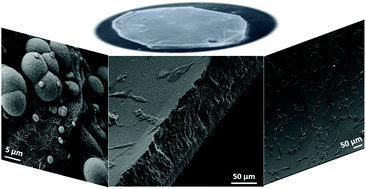Nanostructured interfacial self-assembled peptide–polymer membranes for enhanced mineralization and cell adhesion†
Abstract
Soft interfacial materials, such as self-assembled polymer membranes, are gaining increasing interest as biomaterials since they can provide selective barriers and/or controlled affinity interactions important to regulate cellular processes. Herein, we report the design and fabrication of multiscale structured membranes integrating selective molecular functionalities for potential applications in bone regeneration. The membranes were obtained by interfacial self-assembly of miscible aqueous solutions of hyaluronan and multi-domain peptides (MDPs) incorporating distinct biochemical motifs, including mineralizing (EE), integrin-binding (RGDS) and osteogenic (YGFGG) peptide sequences. Circular dichroism and Fourier transform infrared spectroscopy analyses of the MDPs revealed a predominant β-sheet conformation, while transmission electron microscopy (TEM) showed the formation of fibre-like nanostructures with different lengths. Scanning electron microscopy (SEM) of the membranes showed an anisotropic structure and surfaces with different nanotopographies, reflecting the morphological differences observed under TEM. All the membranes were able to promote the deposition of a calcium-phosphate mineral on their surface when incubated in a mineralizing solution. The ability of the MDPs, coated on coverslips or presented within the membranes, to support cell adhesion was investigated using primary adult periosteum-derived cells (PDCs) under serum-free conditions. Cells on the membranes lacking RGDS remained round, while in the presence of RGDS they appear to be more elongated and anchored to the membrane. These observations were confirmed by SEM analysis that showed cells attached to the membrane and exhibiting an extended morphology with close interactions with the membrane surface. We anticipate that these molecularly designed interfacial membranes can both provide relevant biochemical signals and structural biomimetic components for stem cell growth and differentiation and ultimately promote bone regeneration.

- This article is part of the themed collection: Celebrating Excellence in Research: Women of Materials Science


 Please wait while we load your content...
Please wait while we load your content...